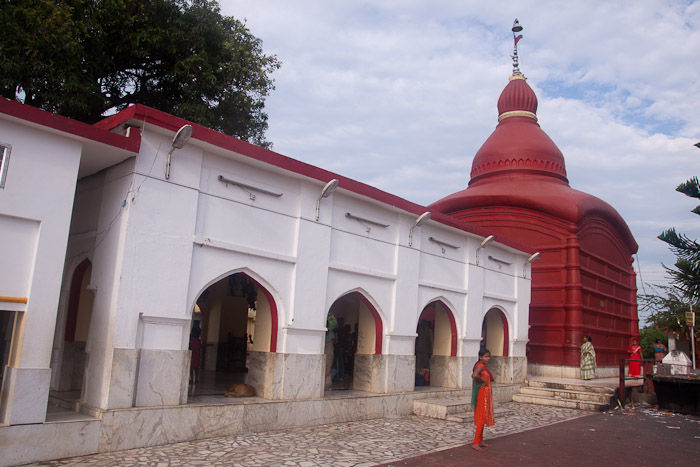This temple is one of the 51 holiest Shaktipeeths (Shrine of the goddess of power ) in India as per Hindu mythology. The temple consists of square type sanctum of the typical Bengali hut structure with a conical dome. The temple was constructed in 1501 A.D. by the then Maharaja Dhanya Manikya.
Tripura Shakti Peeth as one the Shakti Peethas at the top of the hills, near Radhakishorepur village, with a little distance away from Udaipur town of Tripura, India comes existing of Goddess Shakti and Lord Shiva. Yes, the state-Tripura gets its name by dint of Goddess Tripura Sunadri, also known as Turtia Mata.
Goddess Tripura (form of Goddess Shakti) in Tripura Shakti Peeth as in statue of Goddess Kali Maa and Lord Tripuresh (form of Lord Shiva) have their priceless attendance in the temple-Karm temple shapes of tortoise.
In the eastern side of the temple there is the famous Kalyan Sagar lake where fishes and tortoises of huge size are found and devotees feed them with "Muri" (puffed rice) and biscuits. No fishing is permitted in the Kalyan Sagar.
In the 16th of century, King Dhanymanik wished to rule over Tripura. Once, Goddess Tripureshwari was dreamt of his vision while he was sleeping. She said to him to bring her idol from a mountain of Chinta village.
Justly, King Dhanymanik awakened to order his soldiers to bring the idol. As a result, The idol was there to King till sunrise. As ordered by Goddess Tripureshwari, her temple was constructed and the idol was established in it. With time, her temple thereon was known as Tripura Sundari Temple.
Tripura Sundari Temple is situated in the ancient Udaipur, about 55 km from Agartala, believed to be one of the holiest Hindu shrines in this part of the country. Popularly known as Matabari, crowns in a small hillock and is served by the red-robed priests who traditionally, minister to the mother goddess Tripura Sundari.
According to mythology, Lord Vishnu had cut off the body of Mata Sati into 51 pieces with his Sudarshana Chakra and all these pieces fell at different places throughout the country and these places are known as Shaktipeeths.
Considered to be one of the 51 Shakti Peethas, consists of a square type sanctum of the typical Bengali hut. It is believed that Sati's right foot fell here during Lord Shiva's Nataraj Dance. The temple consist a square type sanctum with a conical dome.
It was constructed by Maharaja Dhanya Manikya Debbarma in 1501, there are two identical images of the same deity inside the temple. They are known as Tripura Sundari (5 feet high) and Chhotima (2 feet high) in Tripura.
The idol of Maa Kali is worshiped at the temple of Tripura Sundari in the form of 'Soroshi'. One is made of kasti stone which is reddish black in colour. It is believed that the idol was Chhotima was carried by king in battlefield. This temple is also known as Kurma Pitha because it the temple premises resembles kurma i.e. tortoise.
Do:
- Do pray your Ishta Devata before pilgrimage to Temple.
- Do contact Temple Devasthanam information centre for enquiry, temple information and for Pooja details etc.
- Do reserve your travel and accommodation at Temple well in advance.
- Do bath and wear clean clothes before you enter the temple.
- Do concentrate on God and Goddess inside the temple.
- Do maintain silence and recite your Istamantram to yourself inside the temple.
- Do observe ancient custom and traditions while in Temple.
- Do respect religious sentiments at Temple.
- Do deposit your offerings in the hundi only.
Don't s:
- Do not come to Temple for any purpose other than worshipping of God and Goddess.
- Do not smoke at Temple.
- Do not consume alcoholic drinks at Temple.
- Do not eat non-vegetarian food in the Kshetram.
- Do not approach mediators for quick Darshanam. It may cause inconvenient to others.
- Do not carry any weapon inside the temple.
- Do not wear any head guards like helmets, caps, turbans and hats inside the temple premises.
- Do not perform Sastanga Pranama inside the Sanctum Sanctorum.
- Do not take much time while performing Sparsa Darshanam to God in Garbhagriha.
- Do not buy spurious prasadams from street vendors.
- Do not encourage beggars at Temple.
- Do not spit or create nuisance in the premises of the temple.
